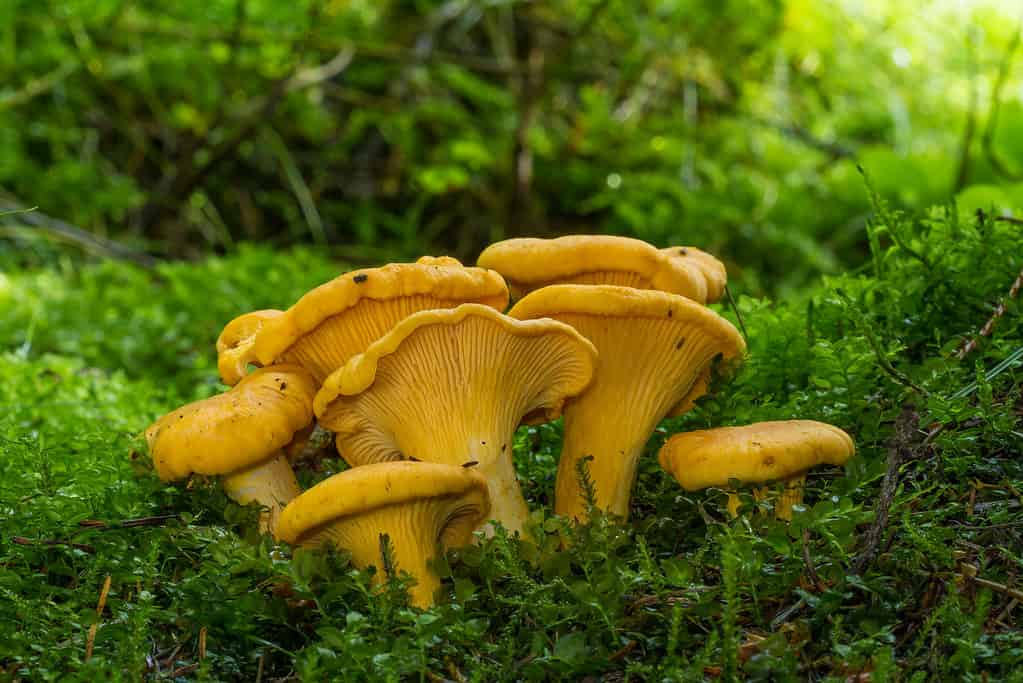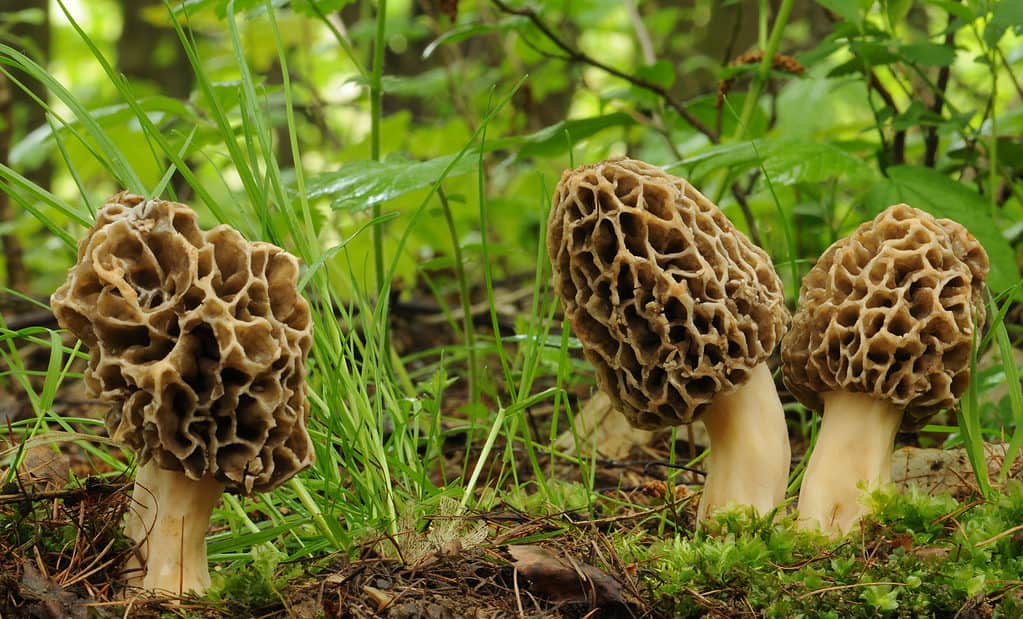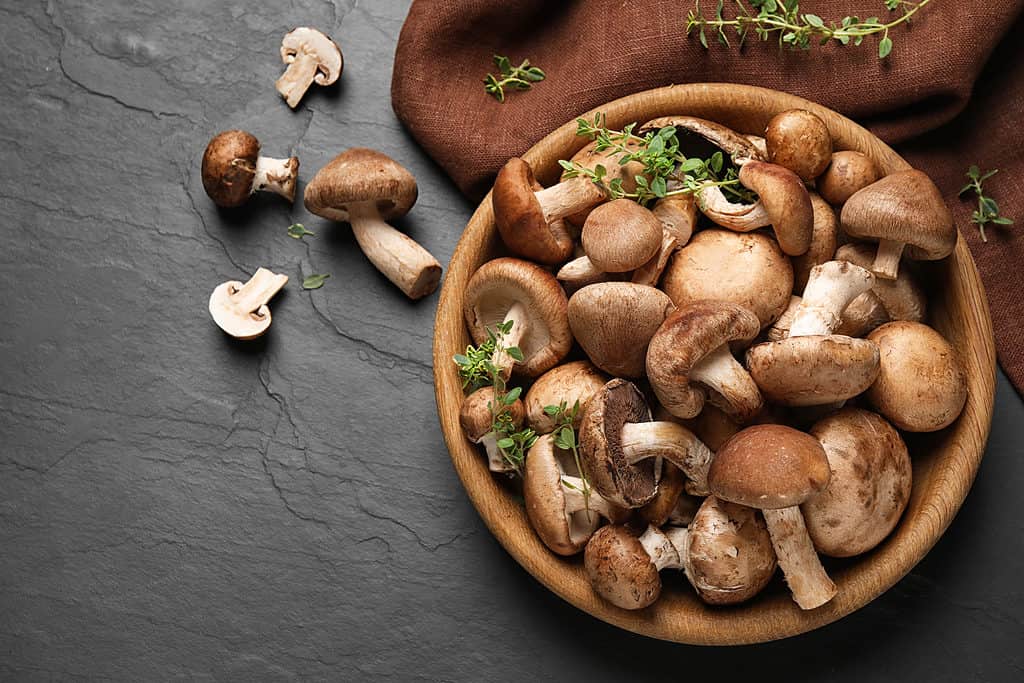Gourmet mushrooms, broadly speaking, are edible mushrooms that are of high culinary value with rich, unique flavors. These mushrooms are more expensive than button mushrooms, and are often sought after for use in at-home and restaurant luxury cooking. Which species of edible mushrooms are considered “gourmet” can vary by culture.
In this guide, we’ll discuss the following highly revered culinary mushrooms:
- Chanterelles
- Morels
- Matsutake
- Shiitake
1. Chanterelles (Cantharellus spp.)

Golden chanterelles growing in the forest.
©godi photo/Shutterstock.com
There are a number of chanterelle species that people covet for their culinary use. The most well-known is the golden chanterelle (Cantharellus cibarius) and the species that closely resemble it in look and taste. While C. cibarius is only found in Europe, there are a number of closely related species in North America. These include the Pacific golden chanterelle (Cantharellus formosus), oak chanterelle (Cantharellus californicus), Cantharellus enelensis and many more.
In North America, from late summer through fall, you can find a number of these C. cibarius-like species sold at gourmet grocery stores, health food stores, and local farmer’s markets.
The flavor of chanterelles can vary, but ones that resemble C. cibarius often have a rich apricot smell and slightly sweet but nutty flavor. Most people prepare chanterelles in ways that elevate their flavor, so people don’t typically bread them or use methods that could mask their wonderful taste. A widely popular way to prepare chanterelles is to sauté them with a dab of butter, garlic, and a dash of salt and pepper.
The price of chanterelles depends on a number of factors, but you can usually expect to pay between $20-30 per pound for fresh chanterelles. All species of chanterelles are mycorrhizal, meaning they derive their nutrients from a beneficial plant-fungi nutrient exchange with various species of host trees. This complicated, interdependent relationship is necessary for chanterelles to grow, and as of yet, researchers have not successfully cultivated them. This lack of cultivation is part of the reason why chanterelles are so expensive.
2. Gourmet Mushrooms: Morels (Morchella spp)

Beautiful and delicious morel mushrooms
©Tomasz Czadowski/Shutterstock.com
Morels in the Morchella genus, aka true morels, are wonderfully unique and delicious fungi of the Ascomycota phylum. These mushrooms grow across the temperate Northern Hemisphere from North America to Asia. They are some of the most popular and delicious mushrooms to hunt in the spring.
In North America, there are at least 20 species divided into the elata clade, the esculenta clade, and the rufobrunnea clade. Generally speaking, we associate the esculenta clade with yellow morels and the elata clade with black and burnsite morels. There is currently only one species of North American morel in the rufobrunnea clade, notable for its distinct color changing upon bruising.
People often describe the flavor of morels as earthy, nutty, and rich. They have a meaty, spongy texture and are popular mushrooms for use in soups, stews, and curries. It’s imperative to thoroughly cook fresh and rehydrated morels to avoid gastrointestinal or even neurological symptoms associated with eating raw or undercooked morels.
You can buy dried morels all year long at various health and gourmet food stores. For fresh morels, you can typically purchase them from late March or early April through June. The cost for fresh morels can range from $20-50 per pound, depending on the species, season, and location. Commercial cultivation of some morel species does occur, but it’s certainly tricky and requires an expert understanding of the complex life stages of these fascinating fungi.
3. Matsutake (Tricholoma matsutake and others)

Matsutake in a basket with confier needles
©ykokamoto/Shutterstock.com
Matsutake are delightful, edible, gilled mycorrhizal mushrooms in the Tricholoma genus that occur in temperate forested regions of North America, northern Europe, and East Asia. Out of over 350 species in this genus, mycologists currently group around 10 species into the matsutake complex. These mushrooms produce wonderfully complex smells and flavors. Their flavor and smell feature an intriguing mix of spicy, fruity, earthy, and a bit musky. Some people even compare the smell to cinnamon flavored used gym socks!
Of all the species we consider a “matsutake”, people probably most covet the Tricholoma matsutake, distributed throughout Japan, China, and Korea. In Japanese, the word “matsutake” translates to “pine mushrooms”, referring to this mushroom’s mycorrhizal relationship with pine trees. This species is where the common name “matsutake” originates for other species in the Tricholoma genus. In North America, the most famous and sought-after American matsutake is Tricholoma magnivelare.
Currently, there is concern about commercial foraging and sales of matsutake species, especially Tricholoma matsutake. This is due to the deforestation and development in their native range that is wiping out the pine trees they form their essential mycorrhizal relationship. As such, T. matsutake is globally Red Listed as a Vulnerable species following a 30% population decline over a 50-year evaluation period. These mushrooms are also known to be overharvested and in not ethical ways. People will sometimes use rakes to pull up the small buttons which seriously disturbs their growing environment while also not letting them grow large enough to emit spores.
4. Gourmet Mushrooms: Shiitake (Lentinula edodes)

Shiitake mushrooms have a wonderfully meaty, chewy texture and complex, savory, nutty taste.
©New Africa/Shutterstock.com
Well-loved fresh and dried for their intense umami, buttery flavor, and meaty texture. Shiitake mushrooms (Lentinula edodes) are one of the most popular, and commonly cultivated, gourmet mushrooms. These lovely mushrooms occur natively in temperate regions of East Asia, especially China, and Japan. They are, however, heavily cultivated in other parts of the world, including North America. You may find them wild in the woods of North America, but those observations are likely from ones that escaped cultivation and naturalized on their own.
Shiitake mushrooms are saprobic on various hardwood tree species. This means they derive their nutrients from breaking down dead hardwood. We can cultivate these mushrooms by growing them on hardwood logs or in sterilized, supplemented hardwood sawdust bags.
While they are one of the most widely cultivated mushrooms in the world, they’re still pretty pricey. In US markets, you can expect to pay $10-20 per pound for fresh shiitake mushrooms. Since growers heavily cultivate them, you can find shiitakes year-round. Both the fresh and dried forms are available at many gourmet and some big-box grocery stores.
The photo featured at the top of this post is © iStock.com/Seqoya
The information presented on or through the Website is made available solely for general informational purposes. We do not warrant the accuracy, completeness, or usefulness of this information. Any reliance you place on such information is strictly at your own risk. We disclaim all liability and responsibility arising from any reliance placed on such materials by you or any other visitor to the Website, or by anyone who may be informed of any of its contents. None of the statements or claims on the Website should be taken as medical advice, health advice, or as confirmation that a plant, fungus, or other item is safe for consumption or will provide any health benefits. Anyone considering the health benefits of particular plant, fungus, or other item should first consult with a doctor or other medical professional. The statements made within this Website have not been evaluated by the Food and Drug Administration. These statements are not intended to diagnose, treat, cure or prevent any disease.
Thank you for reading! Have some feedback for us? Contact the AZ Animals editorial team.






